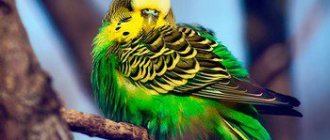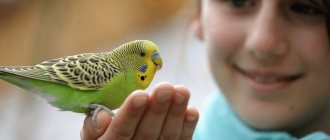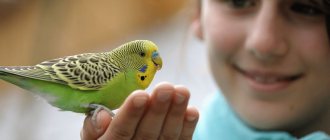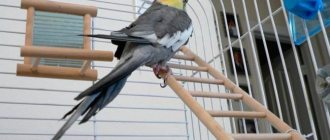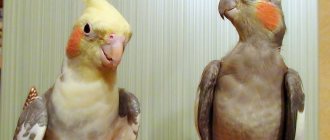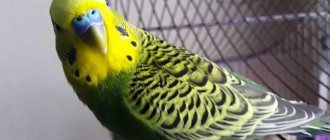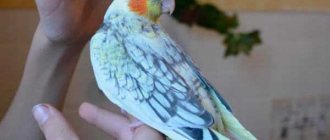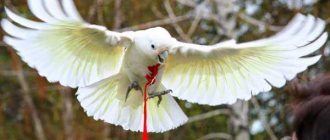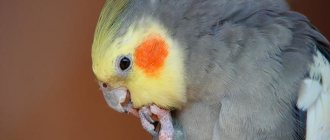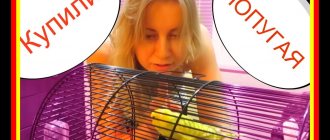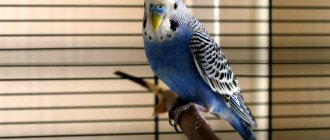The Corella parrot is considered a unique bird that can be kept at home. Nature has rewarded them with amazing abilities and intelligence, which allows them to quickly memorize sounds and human speech. When you hear how a cockatiel talks, you will immediately be surprised that the bird pronounces all the letters and sounds correctly and without errors. But still, teaching her this will require a lot of work and patience. Proper organization of the process is important, which will help the parrot remember a large number of words and sentences.
Is Corella talking or not?
It depends on what you mean by this term. Nymphs can repeat the sounds of human speech, entire words and phrases. They are able to whistle melodies and sing songs. Some birds are taught to make requests for food or treats when they are hungry, that is, to perform a completely conscious action.
But is this really a conversation? Technically no. These are just acquired reflexes that cockatiels develop very well.
The second point is the physical ability to pronounce sounds that resemble human ones. Yes, their vocal apparatus can easily generate them. And also the barking of dogs, the singing of other birds and the imitation of the operation of machines and mechanisms.
Teaching a cockatiel to talk
What else is needed for this ability? Good memory. Again, cockatiels (like many talking parrots, but not all birds in general) have parts of the brain that store a lot of information. Including sound.
In a word, the nymph is very good at making sounds and does it with pleasure.
Cockatiel training
It is impossible to achieve any results from cockatiels if you constantly force them to do something; they are very reluctant to give in to pressure. In general, when training parrots, much greater results can be achieved with affection and constant unobtrusive attention.
In order for your cockatiel to bring you only positive emotions, you need to spend time training it. The tame bird will not leave anyone indifferent and will eventually become a full-fledged member of the family. All you need to tame a nymph is patience and an understanding of what to do and what not to do. Parrots are very friendly and curious creatures, but at the same time, they are quite timid and vindictive; if you offend a bird, it will be more difficult to make friends with it later.
As a rule, a cockatiel can be completely tame only if it is a so-called nurse - a chick that was taken from its parents very early at the age of 1.5 - 2.5 months and fed by hand. In this case, the chick begins to perceive the person as a relative and trusts him completely; such a bird can be cuddled like a kitten and it will like it. Everything is more complicated in the case of a parrot bought in a store, most likely it will never be completely tame (as described above), but nevertheless it can be tamed and it will trust you and consider you a friend, such a cockatiel will sit on your shoulder, head, hand and will allow itself to be scratched, and will most likely learn to imitate your speech.
There are several basic methods of training talking parrots, including cockatiels: › negative reinforcement. The method is based on the presence of an unpleasant or frightening object next to the parrot, which is removed after it carries out a command (for example, upon seeing a towel, the bird returns to the cage); › positive encouragement. This method consists in the fact that the parrot receives encouragement (a treat, affection, verbal encouragement) immediately after performing the required action; › negative punishment. The method is that the cockatiel is deprived of something that it considers pleasant and positive for itself (for example, treats or communication with a person to which the bird is accustomed); › positive punishment. If a parrot is exposed to an unpleasant stimulus immediately after performing an unnecessary action (a stream of water is a hostile or aversive stimulus), the parrot will not act this way in the future.
According to most professional trainers, the most successful results can be achieved if you use methods of negative punishment and positive reinforcement when raising a parrot.
Other methods of influence, when used frequently, can cause a negative response from the cockatiel. It is recommended to use them extremely rarely.
When taming and training a cockatiel, you should choose the right training methods.
In some cases, cockatiels react aggressively to the use of aversive methods. In this situation, it is necessary to alternate aversive methods with encouragement. For example, by showing the cockatiel a towel, you let it know that it needs to return to the cage (aversive method), at which time you need to give the command “Into the cage!” and reward the parrot if the command is followed.
It is necessary to reward the parrot for completing a command with exactly what gives him the greatest pleasure. It is important to remember that if you reward him with a treat, it should not be placed in the feeder. In this case, the treat must be given from the hand and only for the completed action.
For some cockatiels, the owner's affection and communication will be preferable to a treat. To avoid monotony, you need to use several possible rewards (2-3 are enough), and then the parrot will never get bored with the exercises.
You can teach a parrot to perform various actions only if they suit its character. If an action is contrary to the bird’s character, even the most favorite delicacy will not force it to be carried out. A cockatiel can only be tamed and taught something by a person who the bird actually likes and whom it completely trusts.
It will be very easy to find out which treat your cockatiel likes best. To find out, you need to mix in a saucer (but not in the bird’s usual feeder) different types of grains, nuts, etc. This mixture needs to be offered to the bird.
All you have to do is remember what the parrot chose first, what then, and what it ignored altogether. The next day the procedure must be repeated. After 3-4 such tests, you can find out several of the parrot’s favorite treats.
The right choice of treats for training with your cockatiel will significantly speed up the training process.
From the very beginning, you should pay attention and set the amount of remuneration correctly. In this case, you will need to make a compromise - you should give the parrot less treats in order to prolong the sessions, otherwise he will quickly get enough and stop following commands.
Also, the amount of remuneration is determined based on the specific activity. The parrot should receive a large reward for a big success; in this situation, this will be several times more effective than several small rewards.
If the executed command does not seem very important to you, you should still reward the cockatiel. The parrot should receive a reward for each command completed. In any case, this must be done until the parrot quickly and correctly carries out all the owner’s commands.
It would be more effective to divide the training of a parrot into several successive stages; you cannot teach it to carry out all commands at once. The parrot will master the action faster if you don’t demand so much from it at the moment. After he clearly understands the command, you can move on to the next stage of training. It makes no sense to demand that a parrot learn to carry out any command the first time. This is impossible.
Better results can be achieved if you properly distribute the time and duration of classes. A parrot should never get tired during training. Exercises should not bore him. The best results will come from sessions lasting no more than 10–15 minutes. It is best to work with the bird 2-3 times a day.
Things and situations that are not dangerous from a human point of view can cause serious harm to a cockatiel.
Before starting classes, you should carefully prepare for them. For a parrot in an apartment, there are many different dangers that should be neutralized if possible before starting training. The following are dangerous for any parrots kept in an apartment: in the kitchen: › deep vessels with a smooth neck; > shards of glass; › hot plate; > scissors; › adhesive tapes for catching insects; › knives; › spices; > steam; › leftover food; in living rooms: › toys consisting of small parts; › electrical cable; › candles and fireplaces; › rough pile carpets; › ballpoint pen refills; › narrow gaps between shelves and furniture; › open aquariums; › curtains with heavy lead balls; › ashtrays; > glue; › poisonous plants and cacti.
The following plants are dangerous for cockatiels: › lily of the valley; › avocado; › thorn; › heather; › sansevieria; › galtonia; › narcissus; › ivy; › arum; › colocasia; › hyacinth; › gladiolus; › iris; › mistletoe; › laurel; › tobacco; › snowdrop; › Dieffenbachia; › primrose; › black acacia; > coffee; > tea tree; › foxglove; › alocasia; › philodendron; › proleskadracaena; › spurge; > potato; › asparagus; › azalea; › saintpaulia; > tulip; › agave; › camellia; › cycad; › aspidistra; › pteris; › reo motley; › crocus; › trachycarpus.
Direct training of a parrot can begin only after all objects dangerous to it have been removed or closed. The first commands that should be taught to a parrot are usually the commands “Forward!” and “Back!” Remember that these commands do not show the parrot a direction in space. They mean the bird approaching or moving away from its owner, to whom all the parrot’s attention will be directed during training.
When training a parrot, you should stick your hand into the cage and command: “Forward!” The bird should move onto the finger. The parrot can leave the cage only after the appropriate command is given. If the parrot simply moves onto the finger without waiting for the word “Forward!”, this is not considered to be executing the command. Such an action is not obedience, but a habit.
There should be a separate place for regular training (for example, a separate room with a special training stand). His choice depends on the degree of domestication of the cockatiel and its character. At first, some problems may arise: many parrots do not want to leave their familiar cage. If this happens, the parrot should be trained there first.
Corella, like other parrots, always prefers: › an object that is more familiar to it (trying to switch to it); › more stable support; › higher perch or perch.
Corella, before setting foot on a new place, always checks it with its beak. Many inexperienced owners are afraid of this, because it seems to them that the parrot wants to bite them. At the same time, they sharply withdraw their hand and scare the bird itself. To prevent this, it is recommended to use a perch when training a parrot, at least at first.
If cockatiels are caught in the wild, they will subsequently be afraid of human hands. This happens because the bird has experienced stress. But even if the parrot was already born at home, it will instinctively avoid the person with fast and sharp movements. In natural conditions, such movements are most often characteristic of predators.
The end of the perch opposite the one you hold in your hand should be placed on the perch near the parrot. This manipulation will give the perch additional stability, since it is quite difficult to keep the perch and the bird suspended.
When the cockatiel is completely convinced of its safety, it will trust its owner much more. An additional convenience for the parrot is that it will not be forced to cross the empty space between the perch and the perch.
Only with the help of long-term training can you ensure that the parrot moves to your hand or perch at your first request. Only a properly raised bird will do this. A parrot may refuse to move to a perch, especially at the very beginning of training, if the perch seems to him a more stable and convenient type of support.
In some cases, the parrot may stop following commands, become distracted, or start playing. In this case, he must be left alone in the room for a while. For the parrot to calm down, a few minutes spent alone by the bird will be enough. After the parrot has completely calmed down, classes should be continued.
To train a parrot, you need to prepare special training items. There are a great many of them. Items for training should be selected taking into account the character of the cockatiel, strictly individually.
Some breeders advise using regular chairs (instead of a training stand) when training your parrot. It is best to allocate a separate chair for training, since parrots usually chew everything around them, especially what they sit on. Therefore, if you have taught your parrot to sit on a chair, it will be very difficult to prevent him from gnawing on it later. This behavior of parrots is initially inherent in nature. If you cannot allocate a separate chair for training, purchase a special stand for this purpose.
Before teaching a parrot the command “Forward!”, you must first attract its attention (for example, name it). After this, show the parrot a treat and say: “Go ahead!”
When the parrot understands the command “Forward!”, you can move on to the next stage of training. To do this, place your hand or perch between the treat and the cockatiel. The parrot needs to be rewarded with a treat or affection every time it comes to you on command.
It doesn't take long for most parrots to learn the "Go!" command. Usually this command is easy for them to remember.
Many parrots do not dare to climb onto your hand and as soon as they approach, they immediately stop. If you press your finger on the bottom of the parrot's chest, it will step onto your hand.
Any time your parrot gets scared, loses its balance, or flies away, you should give it time to calm down. Perhaps the parrot does not like the place you have chosen for training. In this case, there is no need to return the bird to its original place. A change of environment will benefit the parrot, and he will become more willing to follow your commands.
When the parrot has received a treat, he will try to move away, at this moment command him: “Back!” There is no need to stop it at this moment.
In some cases, the parrot is in no hurry to return to its perch. If this happens, try to bring the parrot closer to the perch so that the perch is between him and you.
In this case, the cockatiel will definitely want to come to you and in any case will step on the perch. At this moment, while carefully removing your hand, you need to command: “Back!” (in this case, although the parrot approaches you, after leaving your finger, it still “moves away”).
Training parrots will be more effective if done in the form of a game. Many parrots prefer varied games to boring, monotonous activities.
Never raise your voice to a parrot. If you strictly follow all the simple rules listed above, your cockatiel will not get tired of doing various exercises, and the execution of all commands can be brought to automaticity. If this happens, in the future, in order for the parrot to do what is required of it, it will not be necessary to repeat commands to it several times.
Before moving on to teaching the bird other commands, ensure that the one you are currently teaching your parrot is strictly followed. During training, you should never rush things. If you rush and constantly urge your parrot, moving on to new exercises without learning the old ones, this will definitely harm the entire learning process. In this case, the parrot may lose previously acquired knowledge.
Having taught the bird to follow the commands “Forward!” and “Back!”, you can move on to the next stage of training. At this stage of training the parrot, you should teach it to follow the following commands: “You can!” and “You can’t!” These are very important commands, thanks to them you will save your cockatiel from many troubles.
Experienced parrot owners have not come to a consensus regarding the use of the “Yes!” commands. and “You can’t!” According to some, these commands help establish a hierarchy between humans and cockatiels. When the parrot learns to follow these commands, he will understand that the dominant role in making all decisions and determining the boundaries of what is permitted belongs to you, and not to him. As a result, you will achieve complete dependence of the bird on your decisions. This is necessary to ensure that the parrot is obedient.
According to other parrot owners, this position is fundamentally wrong. They believe that parrots do not have a very developed concept of hierarchy. It is difficult for Corella to understand and recognize someone's dominant position in relation to her.
Increased dependence on its owner can be dangerous for a cockatiel. This can affect the state of the parrot's nervous system.
Constant prohibitions can cause aggression on the part of the cockatiel, while infrequent (only when necessary) use of the commands “You can!” and “You can’t!” will help avoid this problem, as well as constantly seeking your attention.
To rid your cockatiel of habits that are unacceptable to you, you must give your parrot a choice: do the wrong thing and get a well-deserved punishment, or do everything right and get a reward. With the help of correctly chosen methods of reward and punishment, the parrot will quickly learn all the rules of behavior.
First of all, you should teach your parrot alternative behaviors.
There are times when a parrot tries to get your attention because it wants to communicate. At the same time, he behaves inappropriately - screams, knocks on the grill with his beak, scatters food, etc. Such behavior is unacceptable.
But the parrot doesn't know any other way to get your attention, so that's the only way it will behave. In this case, none of the methods of punishment or reward will help. To avoid this, the parrot must be given an alternative. For example, you should teach your bird to call you by name, whistle, etc. when it wants to communicate.
Another bad habit of all parrots without exception is gnawing all the things that come their way. There is nothing you can do about this - such actions are characteristic of the behavior of a cockatiel in nature and are instincts.
You definitely need to teach your parrot to chew only certain things (for example, toys), which should always be at his disposal. When you leave a parrot alone in an apartment for a long time, it is still better to remove all valuable and dangerous things for it.
Before teaching your parrot the “No!” command, you should clearly understand what exactly this command should mean. It is necessary to give this command only one meaning; it should be given only in the case of some specific actions prohibited for the parrot.
In any case, the command “No!” for a parrot should mean: “Whatever you are doing now, stop immediately.” The command “No!” can be given in two cases: when the parrot commits an illegal action or just wants to do it.
If the parrot has followed the command correctly, it must be rewarded with some kind of treat. For example, if a parrot was tearing wallpaper or a magazine, but stopped doing it after the command “No!”, it should be immediately rewarded. By doing this, your cockatiel should develop the necessary obedience skills. But it should be remembered that under no circumstances should you scold the parrot for the harm caused.
If the parrot does not pay any attention to your commands and continues to do its own thing, you must get its attention. To do this, it is enough to make some unexpected movement. A parrot can also be attracted by an unusual sound. All parrots are naturally very curious, so the bird will immediately be distracted and turn its attention to you. At this moment, she will naturally stop doing something illegal. You should immediately praise your parrot and reward him with a treat.
You must remember that you cannot make sudden movements, otherwise this will cause aggression on the part of the parrot. If you scare a parrot, it may even attack you.
Sometimes using an object that the parrot doesn't like can have a positive effect. Such an object can be, for example, a towel; birds usually do not like it. Showing a towel from afar, say in a stern tone: “You can’t!”
If the cockatiel always receives some kind of reward for following a command, this is quite enough. Subsequently, the command “No!” Can be served without a towel.
Team “It’s possible!” is the opposite of the “No!” command. If the action that the parrot is about to do is approved by you, you can give this command. At the same time, you don’t have to reward the parrot for following the command, since the permission itself will be a reward for the bird.
The command “It’s possible!” should also be used in situations where the parrot itself takes the initiative. For example, if he wants to communicate with you, you can allow him to do so by issuing the appropriate command.
If some actions are sometimes allowed to the cockatiel, and sometimes not, the “Can!” command will help you explain this correctly to the parrot. In some cases, this may also apply to his communication with you. If the parrot wants to communicate, but you don’t want it or are busy at the moment, you should command: “No!” After you are free, you should command: “You can!”
All parrots, including cockatiels, are very impressionable and suggestible. Understanding various commands in some cases requires the parrot to think abstractly. To properly tame and raise a parrot, you need it to fully concentrate on you. During classes, neither you nor the parrot should be distracted by anything. A parrot that is sufficiently accustomed to communicating with humans is much more successful in training. According to some cockatiel owners, before starting training, the bird should trim its wings a little, this should speed up the learning process. This procedure is painless and will not cause any harm to the parrot. In a maximum of six months, the feathers on the wings should be completely restored. This procedure is also suitable for an untamed parrot, since with clipped wings it will not accidentally fly out of the window during training. Nevertheless, it is still not worth taking a parrot with clipped wings outside.
With clipped wings, parrots can fly only a few meters.
Nonverbal gestures also influence the parrot's understanding and execution of various commands. Therefore, before performing any gesture, think about how the parrot will perceive it.
Before you start training parrots, you must adhere to the following recommendations: › before you start training, mentally imagine the entire learning process, think through the details of each individual exercise. Think about what command your cockatiel should learn and how you will reward it for it; › start training with your parrot only when you are in a good mood. Remember that the parrot will definitely sense if you are upset or a little tired. Usually, having felt this, parrots refuse to follow commands and continue learning.
Many experienced parrot trainers note that after a while the bird’s mood begins to coincide with the mood of its owner. If the owner is in a bad mood, the parrot will also often become irritated and show aggression, at which time he even screams more than usual.
When training, adhere to the following recommendations: › at the very beginning of training, explain to the parrot in a calm voice what you expect from it, what exercises it has to perform. This should calm the parrot; › never train for a very long time. Make sure your classes are not boring. Training should be fun for both you and your cockatiel; › when training your parrot, fully concentrate on your studies; nothing should distract you and the parrot; › if you are in a bad mood, it is better to postpone training for several hours; you should not practice with a bird if you are in a bad mood; › do not expect that the parrot will quickly master all the commands and immediately carry them out clearly. Rejoice at every result, even if it is insignificant; › do not make too sudden transitions between already mastered exercises and completely new ones. New exercises should be approached gradually, alternating them with old ones; › the lesson must end on a positive note. If the parrot does not follow a new command, give it one that it already knows. After the bird completes it, the activity should be stopped. Be sure to reward your parrot with a treat or affection at the end of the training.
Various games should definitely arouse the parrot's interest and please him. If several birds are kept in a cage at once, they can play with each other. Cockatiels love to play with their owner. During play, parrots use a wide variety of objects.
By playing interesting games with your parrot, you bring him closer to you. In addition, during the game, the parrot very quickly becomes attached to its owner.
Knotted Rope To play this game with your parrot, you will need a rope to hang from the ceiling or secure to the bird's tree.
Tie several knots on the rope, which should be at different distances from each other. The rope should be strong enough, but not very thin. Any parrot will love playing with knots. To further entice the bird, you can hang several special rings and a swing between the nodes.
Game exercises This entertaining game will bring a lot of pleasure to your cockatiel. Secure pieces of fruit or vegetables (apple, carrot, banana) as high as possible. Before eating, the parrot will have to work a little to get them.
In some cases, you can use a pole for variety. Trying to get to the treat with the help of a pole, the parrot will simultaneously perform gymnastics for its paws. Pieces of cookies or fruit can be secured between indoor (non-poisonous) plants.
Swing All parrots, including cockatiels, love to swing on swings. You can buy them at a pet store or make them yourself.
You can make a swing from half a coconut. After drilling 3 holes in the coconut, hang it with a rope. You can put your parrot's favorite toy or pieces of vegetables in the swing. If you fluff the rope a little or tie branches of varying thicknesses to the swing, the cockatiel will like this swing even more.
Ball If you have a small ball, you can play an interesting game with your parrot. A ping pong ball will also work. Stand in front of the parrot and carefully push the ball towards it. The cockatiel will quickly understand what you want from it and will join the game, pushing the ball back with its head or beak.
Box For the next game you will need a small box in which you need to cut several holes of different diameters. Place pieces of vegetables or fruits in the box. Of course, the cockatiel will immediately try to get them.
Piggy Bank If you still have an old, unnecessary piggy bank, you can use it in the game with the parrot. Take a few small coins and scatter them on the table near the parrot. So that the parrot understands the essence of the game, put the first coin in the piggy bank yourself. Then the parrot can handle it on his own.
Puzzle Place several pieces of different sizes on the table, maybe a construction set, and start taking them apart. When the parrot sees what you are doing, he will definitely begin to help you.
Playing in the water Pour a small amount of water into the bath so that the parrot can bathe in it. Throw your parrot's favorite toy into the bath, this should attract his attention. The noise and splashes when the toy falls will surprise the parrot. After a while he decides to take a swim.
Is it possible to teach speaking?
This question should be understood as follows: is a particular owner capable of building a relationship with his pet so that the parrot begins to pronounce words and phrases.
The process itself is long and it does not begin with memorizing sounds. In addition, there are many nuances that hinder or help the process. Some of them will be leveled out, others will not.
Read also
How do half-parrots differ from budgerigars?
How to teach a cockatiel to speak in 1 day
Modern technology will help speed up the learning process
Interesting: Canary singing: how to choose a bird and train it
To expressly teach a parrot a few words, you need to use technology: a computer or smartphone. The parrot will need to be left alone with the speaker running all day. Using a microphone, you need to record words that the bird will hear periodically throughout the day.
Files are played every hour or half hour. You can program this playback mode on your computer using the xStarter program, which will launch the player at the set time and with the required frequency. A capable bird will begin to pronounce 1-2 words by the end of the day.
But teaching speech cannot be completely trusted to technology. If the parrot hears only recorded speech, the bird will only speak words when alone.
When leaving the bird alone with the computer, you need to install the equipment so that the inquisitive pet does not harm it.
Age
The birds most susceptible to learning are young birds. It is unlikely that chicks can be taught to speak at all; their vocal apparatus is just beginning to form. But with those on the wing, you can already practice reproducing human speech.
The older the cockatiel, the more difficult it will be to teach him to speak. Difficulties will also be added by the fact that a mature parrot gets to a new owner from an old one, and the previous one did not try to train it, or did it incorrectly.
Very old birds will not show any interest in any tricks of the teachers. His way of life is established, and it will not be possible to stir up the feathered one. Here he himself will most likely share his wisdom with you.
What you need to know before starting training
Corella parrots belong to the cockatoo family, they come from Australia, where they have another name - nymphs. These small birds (their body length reaches 30–33 cm, about half of which is the tail) love communication, therefore they respond well to human company and are easy to train. One of the most interesting abilities is the ability to imitate sounds so accurately that they can even speak clearly. Cockatiels are often turned on precisely because of the capabilities of their voice. Unlike other breeds of birds, they produce more melodic and pleasant sounds.
Corella parrots are often kept because of their ability to learn.
The learning outcomes largely depend on the individual; important factors are:
- Floor. Male cockatiels, for the most part, learn sounds easier and faster. Many even believe that females cannot talk at all, but this is not true, it just requires more effort and patience. At the same time, you need to remember that gender is not a death sentence, because there are both silent males and extremely talkative females. There are no special techniques for training girls, it just may take more time.
- Age. The older the bird, the more difficult it will be to teach it to sing and talk. Young individuals aged 2–3 months are most prone to imitating sounds. When training an adult bird, you will have to wait quite a long time for results.
The possibilities of a bird are not limitless. Corella will be able to remember a maximum of 25–30 words and several sentences using them (but no more than 3–4 members). The pet will be able to play several melodies, perhaps he will even pronounce individual words or lines from a song.
You need to understand that a parrot can only reproduce memorized combinations of sounds; it does not conduct a conscious conversation with a person. Owners usually teach the bird phrases from a specific dialogue, and then plays it back - this gives the impression that they are communicating.
The period of training before obtaining the first results is also individual, it depends both on the bird itself and on the efforts of its owner. If you practice persistently and according to the rules, then after 10–14 days you will be able to hear a clear word from the smart parrot. There are no ways to train a pet in either 5 or 20 minutes, since memorization requires systematic repetition.
Gender
The common belief that female parrots are not at all capable of learning to speak is refuted by documented facts.
The influence of a parrot's gender on its learning
The process with them is much more difficult, that's for sure. And many owners give up without achieving results.
Let's look at why this happens:
- females by their nature are more closed, secretive and reluctant to make contact;
- they have frequent hormonal surges that interfere with the calm training process;
- building a nest, laying eggs, caring for offspring - this comes to the fore for the female and occupies all her attention and thought processes.
If you still decide to achieve your goal and want to teach a girl cockatiel to speak, then you need to be extremely patient. And the most important thing is to establish trusting contact (even more than with a boy).
Lifestyle
They prefer wooded areas, which are located mainly along the banks of rivers or open eucalyptus groves, savannas overgrown with low bushes. They often sit on the tops of old dry trees and on tall bushes. Thanks to their coloring, they remain invisible to many predators. When cockatiels sit high on a tree, they can let a person get close enough, but when they are in the grass they are very shy. That is why cockatiels try not to land on the banks of reservoirs out of caution. They dive vertically down and land directly on the water, or, after sitting down and taking a few quick sips at the water's edge, they take off.
The main diet consists of seeds of herbaceous and many woody plants. Drought in Australia is often associated with fires. After them, the cockatiels have to be content with the surviving plant seeds. But the drought gives way to the rainy season. After the rains, a period of rapid flowering of plants and the growth of young shoots begins. It's a feast for the parrots. Corellas readily eat bark and buds on young branches of bushes and trees. “Graze” on areas of land with emerging grass seedlings. They feast on flowers and do not disdain protein foods, eating insects and snails. In a word, they get everything they need for the breeding season.
Features and character of a parrot
Corellas are paired birds. If you have two birds, then it will be extremely difficult to train a male or female. The most suitable moment for this occurs at a very young age of parrots. Then nature will take its toll, and they will focus only on themselves, their offspring and arranging their common life.
Characteristics of the Corella Parrot
On the other hand, we see facts when birds living in pairs repeat words and phrases. This could be for two reasons. First, the bird acquired this skill before the appearance of a partner. The second is the skill of the owners, who were able to establish a very close and trusting contact with their pets.
Breeding period
Corellas breed during or after the rainy season, when food abundance appears. Pairs nest in the voids of thick branches and trunks of dried trees. The nest is prepared mainly by the male, the female helps a little.
A clutch usually contains from 3 to 8 white eggs. On average, this is 5. Both parents take part in incubation, which is why they differ from other parrots. The female sits at night, the male replaces her with the first rays of the sun. Birds do not leave their eggs for feeding. They also eat in shifts. The incubation period is on average 18-22 days. The hatched chicks are blind and covered with yellowish down. Parents feed them in the same way. Incubation of the clutch is replaced by incubation and heating of the chicks. After a month and a half, the young leave the nest. However, the parents continue to care for and feed the young for some time. Then the pair goes to the second clutch. In the second clutch, there are already fewer eggs. Due to the severity of the life cycle of the Australian semi-desert, girls are born in a noticeable majority in broods of cockatiels, since the possibility of continuing life is important for the preservation of the species. There are cases when there are not enough males and they are divided into two families for the sake of procreation. Australia is famous for the severity of interspecies competition and difficult conditions for the survival of many bird species.
Choosing a parrot that is capable of training
So, let’s summarize and draw up a portrait of an ideal talker.
- It should be a youth, already flying, but not too mature.
- If you don’t want to be completely immersed in your pet’s life, and setting records and super achievements is not your thing, then choose a male as your student.
- A single parrot is your choice. With couples, you will have other interests that are also extremely exciting.
And something else we didn't talk about. If you have the opportunity to observe your future pet, then listen to its sounds. A chick that is louder, more melodious, and most importantly has a more varied voice, most likely has good learning abilities for conversation.
Choosing a trainable parrot
Trust is the path to success
Nymphs are active creatures, very sensitive to their surroundings. If the pet was taken from a store, then from a very young age he lived in a state of constant stress. The mass of people passing by frightened him. Things are a little better with birds from nurseries.
The owner’s first task is to provide the newcomer with the most comfortable living conditions. It is necessary to observe the light and sound regime, take care of proper feeding, and choose a suitable cage. These everyday issues are only the first step towards establishing trust.
Read also
Is the tick in a budgerigar transmitted to humans
? At the same time, the owner needs to establish contact with the pet. Constantly communicate with him, offer games, spend time together. You should not put pressure on your cockatiel or try to forcefully establish a relationship, this will have the exact opposite effect.
To train a cockatiel, you need to create a trusting relationship.
It is worth starting training after all the obstacles have already been removed, and you feel that the bird is not afraid and accepts it as one of its own.
Repetition is the mother of learning
Every day in the morning (this is the period when cockatiels are most receptive), go to the cage and say the phrase you are learning. Speak clearly several times. Back up your words with action. For example, "Hello!" and nod.
The action will attract the nymph's attention. If there is a sound response from the bird, any kind - even a whistle, even a trill, then repeat it again and again. If the tone of the response changes and becomes closer in sound to the word, then the process is underway - the cockatiel has understood what is required of him.
Repeating words for better results
Some disadvantages
Due to its character and habits, this bird is not suitable for everyone. Therefore, before purchasing it, you must carefully study all the features of the breed.
Among the disadvantages of cockatiels, it is worth knowing about several:
- They create a mess. They scatter the remains of their food all the time. And it doesn’t matter at all whether they eat in a cage or in a room, the food will still be far from the feeder.
- They leave behind a lot of garbage. This applies to droppings in any part of the apartment and feather residues after cleaning.
- Produce a lot of dust. It is recommended to carry out wet cleaning at least once every 2 days. Otherwise, it quickly accumulates. And during bird walks it will rise into the air.
- The desire to chew on everything. Even if a bird has a large number of its own toys, it may be interested in documents, photographs, indoor plants, furniture and other interior items.
Important! Despite its disadvantages, the advantages of this breed significantly exceed them.
Monotonous repetition method
In the proposed version, the main emphasis is on clearly pronounced sounds. Choose a time, put away all the toys. Absolutely anything that can distract a parrot from its activity. Start saying the word, over and over again. The nymph must understand that his only entertainment for the next 20 minutes will be listening to this phrase.
If you isolate the cell from an external light source, the effect will be better. The main thing in this method is good motivation of the teacher, since the previous method involves a game moment, but here there is obvious “cramming”. However, such training is only more effective if you accidentally do not fall asleep.
How many words can a cockatiel remember and pronounce?
If your student meets all the parameters, is healthy both emotionally and physically, then in the first year of study he will be able to remember up to 10-15 words and phrases. Then the ability to memorize will decline and stop completely by the age of 5-6.
A well-trained cockatiel can speak up to 35 phrases. Apart from this, there are unique people who can sing a short song.
How to teach a cockatiel to sing. How the cockatiel sings. Cockatiel sings
What not to do
You cannot punish a student. In the previous chapter we talked about the parrot's ability to understand emotions. So, negative emotions affect the bird more than positive ones. If you scold your pet, then he will lose the desire to undergo training. And your contact and trust in you on the part of the cockatiel will be undermined. In this case, everything will have to start all over again, and time for favorable learning may be lost.
Do not hit the bird under any circumstances. No comments needed here at all.
HOW TO TEACH A PARROT TO SPEAK? My experience. | Rocky Life
Health and illness
With proper care, the cockatiel rarely gets sick. If this happens, the main thing is to promptly seek help from a veterinarian. Then there is a chance to save the bird.
- Parasites. You need to watch the bird. With apathy and loss of appetite, it is worth talking about the disease. The plumage can tell a lot if it is dull or brittle - this indicates infestation with parasites.
- If the plumage is severely damaged, the cockatiel may be bothered by bird mites. In this case, you cannot do without the help of a veterinarian. Feather or scabies mites cause serious pain to the bird.
- Cockatiels are susceptible to intestinal diseases. A sign of a disturbance in the functioning of the stomach will be soiled feathers near the cloaca.
- The consequences of a poor diet can be muscle atrophy, and the contours of the bird’s chest can be felt.
- Goiter inflammation. An important point is the condition of the beak. It should be shiny without abscesses or tumors.
- Conjunctivitis. The eyes should be clear and clean and free of pus.
